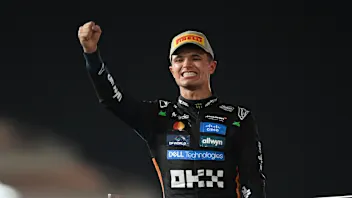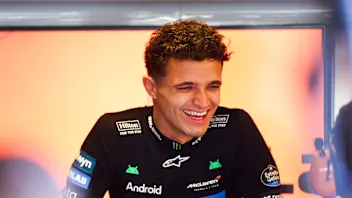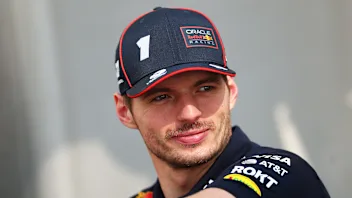Six appeal - 6 fascinating facts about Tyrrell’s six-wheeler
40 years ago this month, Jody Scheckter took Tyrrell’s revolutionary 'Project 34' car to victory in Sweden. To mark the occasion, here’s our lowdown on F1’s only six-wheeled race winner…
1. Jackie Stewart choked on his drink when he was told about the concept
According to Derek Gardner, the man behind the P34’s revolutionary design concept, Jackie Stewart had a “fit of choking” when, on a flight home from the 1975 South African Grand Prix, the designer snuck into the first class section of the plane and informed the retired three-time world champion of his outlandish plans for Tyrrell’s next challenger. But what had convinced Gardner to think so radically? Put simply: F1’s increasingly level playing field.
In the mid-Seventies almost every team on the grid (save Ferrari) was using the same Cosworth DFV engine, the same Hewland gearbox and the same Goodyear tyres, meaning that it had become extremely hard to find what Gardner termed ‘an unfair advantage’. Thinking outside the box, the designer revisited an idea he had first conceived while thinking up a way to improve the handling on Lotus’s four-wheel-drive gas turbine IndyCar of 1968 - a six-wheeled car.
“I did some calculations, and concluded that if I had a car with four small front wheels, contained within the width of the bodywork, I could reduce the amount of lift generated by normal front wheels,” Gardner told Autosport magazine. “That in turn would allow me to back off on the front aerodynamics. And, hey presto, the figure I came up with was the equivalent of 40-odd horsepower!”
2. The design was kept a total secret - even from the drivers
After getting Ken Tyrrell’s blessing to press ahead with a prototype design (which was so leftfield that the team dispensed with their usual chassis naming policy in favour of the 'Project 34' tag), one of the first things Gardner had to do was convince Goodyear to produce the tiny 10-inch tyres that were so integral to the concept. The tyre firm were happy to oblige, and were similarly discrete. In fact, the project was kept so secretive that according to Tyrrell pilot Jody Scheckter, the drivers didn’t even know what the team were working on.
Such stealth tactics ensured that when the car was finally revealed to the wider world jaws predictably hit the ground. Renowned F1 journalist Denis Jenkinson was one of the first to see the P34 in the flesh. "When Ken Tyrrell rings you up and says: 'Can you come over, I've got something to show you', you don't ask: 'What?' or 'Why?'” recalled Jenkinson in his book Jenks: A Passion for Motorsport. “I got on my motorcycle and rode over to Ken's house in West Clandon, and after a welcoming cup of coffee he said: 'Come out into the garden'. Totally unprepared for what to expect, I followed him out to the lawn and my mouth fell open, and a look of total disbelief came upon my face. Ken roared with laughter as I stood there speechless…"
3. It was successful right from the off…
It wasn’t until the 1976 Spanish Grand Prix at Jarama - the fourth round of the season and the first race in Europe - that Tyrrell unleashed their radical six-wheeler, providing a lone chassis for Patrick Depailler while Jody Scheckter raced on in the more conventional 007.
By this stage the P34 had been tested extensively, and was showing bags of potential, particularly in terms of turn-in. This potential was realised almost instantly when Depailler promptly qualified third on the grid - 11 places ahead of his team mate. In the race the Frenchman would fall victim to a braking issue - one of the P34’s most common afflictions and a symptom of its tiny front wheels - but Scheckter would bring the car home in fourth in Belgium a fortnight later.
On an upward curve, things went even better next time out at Monaco where Scheckter and Depailler were second and third behind Niki Lauda’s Ferrari as the P34's handling advantages came to the fore. But the high water mark was to come at Sweden’s Anderstorp circuit where, in just the car’s fourth ever race, Scheckter put the six-wheeler on pole and then led Depailler home in a famous one-two, once Mario Andretti’s Lotus had expired.
4. …but Jody Scheckter was never a fan
For all the success Jody Scheckter had in the P34 - one win, one pole, five podiums, third in the world championship - the South African has never spoken favourably of the P34, reserving particular scorn for the car’s brakes.
With four front tyres and six axles, brake balance was no longer just a matter of front-to-rear, but rather front-to-front-to-rear - something which would play havoc with the car’s handling as the wheelbase effectively lengthened or shortened depending on which axle locked. “The braking was supposed to be better: well, it was when you were braking in a straight line, but as soon as you turned in, the little wheels slid and you had to come off the pedal, so there was no advantage there,” Scheckter told Motor Sport magazine in 2008. “It only really worked on very smooth surfaces and, back then, there just weren't many of those around."
Ronnie Peterson, who drove the car in 1977, could never get on with the six-wheeler either, but Depailler, who is routinely credited as being a major driving force for the project and scored eight podiums with the car over two years, was a much bigger fan, revelling in its ‘pointy’ oversteer characteristics.
5. It featured ‘portholes’
Today’s drivers take it for granted that they can see their front tyres - where they are positioned on the race track; whether they’re locked; how much wear they have. But for drivers of the P34, catching a glimpse of the tyres over the side of the cockpit wasn’t an option. The solution? Portholes.
Normally more associated with maritime vessels, these windows on either side of the cockpit allowed the drivers to see their front rubber and in theory aim their cars more accurately through corners, though in practice they often became so caked in dirt they were unusable. However, the porthole did come in handy at Anderstorp in 1976 when one of the front-left tyres suddenly parted company with Scheckter’s car in practice. Initially suspecting he had a puncture, the South African was alarmed to look through the window and see a stationary brake disc and no wheel…
6. Its true pace was never realised
If the P34’s rise to race-winning status was swift, it’s decline and eventual abandonment was almost as fast. But why did Tyrrell give up on the six-wheeler at the end of 1977? The main answer was tyres. While Goodyear continued to develop their full-sized rubber throughout the ’76 season, development of Tyrrell’s bespoke mini tyres was, in Gardner’s words, almost “non-existent”. That meant that as time went on the car became increasingly unbalanced front to rear, negating one of the main advantages of having four front tyres in the first place - improved front-end grip.
What the car might have gone on to achieve with the right rubber, we’ll never know - though the P34 has become a frequent race winner on specially-made tyres in historic racing. Regardless, while March, Ferrari and Williams all built prototype six-wheelers (all with four driven wheels at the rear), Tyrrell remain the only team to have raced and won with more than four wheels. A truly unique achievement - and one that, thanks to the banning of six-wheeled cars in the early Eighties, will never be matched.
- Jonny Reynolds
Next Up
Related Articles
 The elite group Norris joins as McLaren World Champion
The elite group Norris joins as McLaren World Champion Norris praises support from Hamilton, Vettel and more
Norris praises support from Hamilton, Vettel and more.webp) End Of Year Reports 2025Mercedes’ best and worst moments from 2025
End Of Year Reports 2025Mercedes’ best and worst moments from 2025 End Of Year Reports 2025Williams’ best and worst moments from 2025
End Of Year Reports 2025Williams’ best and worst moments from 2025.webp) End Of Year Reports 2025Alpine’s best and worst moments from 2025
End Of Year Reports 2025Alpine’s best and worst moments from 2025 Verstappen reflects on Mercedes talks and F1 future
Verstappen reflects on Mercedes talks and F1 future